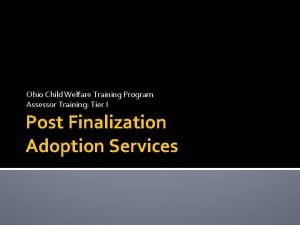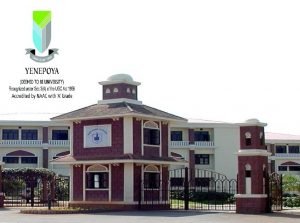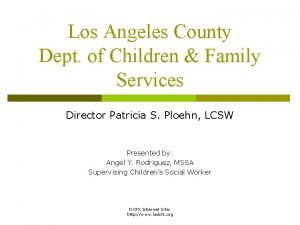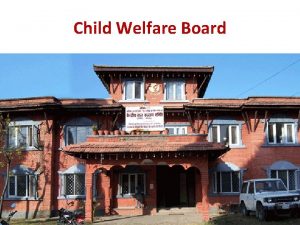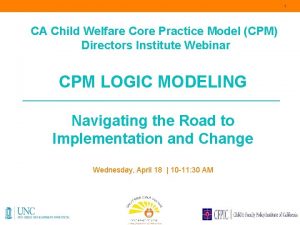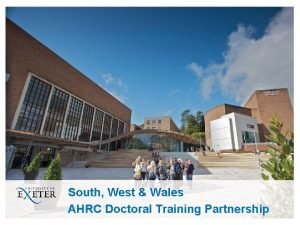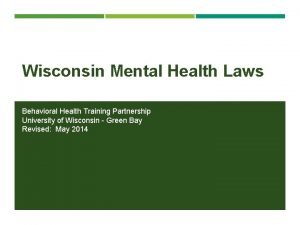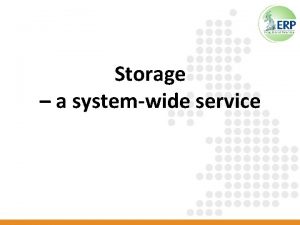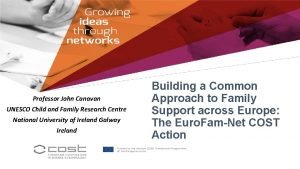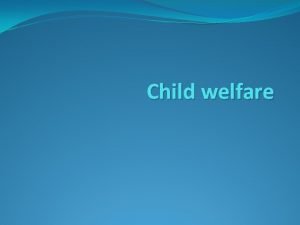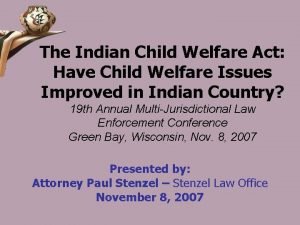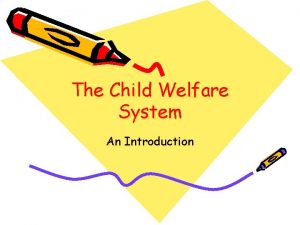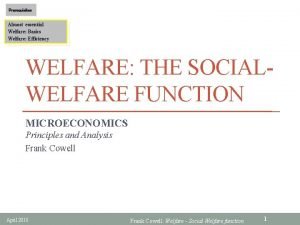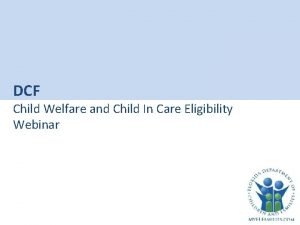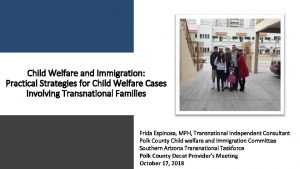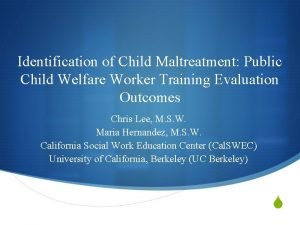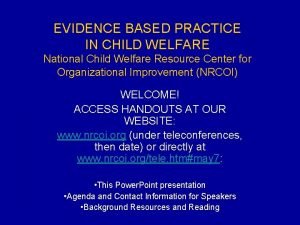Child Welfare Partnership for Research and Training CWPART






















- Slides: 22

Child Welfare Partnership for Research and Training (CW-PART) San Jose State University School of Social Work Implementation years: 2011 -2013 New model components: Mutual Partnership Activities Presenters: Laurie Drabble & Kathy Lemon

Problem Statement and Operating Theory of Change Need for a workforce that understands the value of research and is capable of using data for evaluation and planning. Gaps in research and evaluation capacity on organizational level. Need to strengthen connection between research and practice in social work education.

Core Frameworks Community-Engaged Research Model (Teams & Partnership) Implementation Science (Practice-Based Research) Adult Learning Theory (Situated, Applied Learning)

Logic Model for the Child Welfare Partnership for Research and Training: Implementation of Evidence-base practices and knowledge utilization Partnered Research Teams Research • Teams of students, faculty, & agency staff plan and conduct research on agencydefined priorities • Applied training for MSW students in conducting research Short Term Outcomes Intermediate Outcomes Students & professionals: • Motivation to learn research and use it in practice, • A positive attitude toward evidencebased practice. Partnership: • Completion of pilot projects Students & professionals: • Research knowledge • Knowledge about priority topics Partnership: • Increased social capital and collaborative research capacity Dissemination • Teams of students, faculty & agency staff disseminate research to key groups using a variety of multimedia methods Long-Term Outcomes Students & professionals: • Use research information is a variety of ways Partnership: • Institutionalized University/agency partnership for improved research Contextual Moderators Learning Organization: • Organizational culture and climate that is supportive of research, critical thinking, creativity, innovation and experimentation. • There is coworker and supervisor’ support for using new skills and innovations • Purveyors or champions of practice/policy changes identified University-Agency Partnership: • Teams include participation across hierarchical system levels • Sharing of resources, skills, experiences, insights, ideas and knowledge between and within SJSU and child welfare systems • Positive partnership attitudes and mutual trust among SJSU and child welfare professionals

Core Components: Community Engagement & Partnership Development Organizational partnerships between the SJSU School of Social Work and Santa Clara County’s DFCS Team partnerships between students, faculty, Field Instructors, and county representatives Collaborative research teams: Strengthen relational capacity of students, and Build on cross-systems relationships by “closing the gap” between student/FI, student/faculty, and FFL/faculty/DFCS researcher relationships

Core Components: Research Teams of students, faculty, field instructors and other interested stakeholders focus on research questions defined as priorities by the child welfare agency Students complete research over the academic year and satisfy MSW course requirements in the process. FIs support students as part of their supervision

Core Activities: Planning Phase Faculty and community partners work together to identify prospective research topics and questions Possible projects are evaluated based on several criteria: ◦ Priority for county partner(s); ◦ Availability of faculty team leaders with appropriate expertise (content and/or methodological); ◦ Feasibility (e. g. access to data); and ◦ Availability of interested student team members.

Core Activities: Implementation Phase Student team members work under the supervision of faculty to conduct reviews of literature, collect and analyze data, and develop written reports. County partners and faculty work together to coordinate logistics and solve problems as needed.

Core Activities: Final Phase Dissemination Activities: Findings are shared with partners through a showcase presentation Faculty and students attend stakeholder groups so that findings and their implications can be discussed County partners, faculty, students, and other stakeholders are invited to provide evaluative feedback about their experiences Research briefs are posted on the web

Key Implementers and Roles: Field Instructors Discuss with students their general research area and provide feedback as appropriate Refer students to key informants in the agency/community who may help inform the project Work with students to identify obstacles in the research process and next steps for addressing problems Identify and discuss the types of skills needed for collaboration while working in small groups (i. e. being patient and productive)

Key Implementers and Roles: IV-E and Other Students volunteer for a team based on their interest in the project topic Students work with the faculty-lead and the other students in their team to: ◦ Review the research literature, ◦ Collect/analyze data, ◦ Interpret findings, ◦ Identify practice, policy and research implications and ◦ Disseminate findings to agency partners Through this process, students complete MSW course requirements

Key Implementers & Roles: Faculty Work with agency advisors to select research topics and identify data sources Send announcements to students over the summer about team topics and recruit students for teams Over the academic year, faculty supervise students’ research projects and collaborate with agency partners

Sustainability & Ongoing Evaluation ◦ Integration into IV-E program and into the MSW course structure ◦ Integration into FI orientation/training ◦ Development of agreements, timelines, and productive working partnership with county child welfare agencies ◦ Evaluation is used to inform ongoing planning

Evaluation Highlights: Student Outcomes Survey data indicated that students who participated reported: Engaging in applied and collaborative research activities to a greater degree than other students, including: ◦ Researched a problem or issue that is directly relevant to the agency; ◦ Presented findings to community and agency stakeholders) More positive learning outcomes than students not in teams: ◦ Perceived that research contributed to the field ◦ Interested in being a part of research and evaluation in the future

Evaluation Highlights: Student Outcomes • Focus groups found that teams offered: 1) Increased support and guidance, 2) Learning from different perspectives, 3) Learning new skills

Evaluation Highlights: Partnership Development Outcomes FII project provided a mechanism for more focused and cohesive communication and collaboration between the partners (Focus Groups) Partners strongly endorsed the value of the collaboration (Survey) A supplemental agreement with FIs helped to formalize partnership/involvement

Lessons Learned 1. Support of leadership in both the agency and university contexts is critical 2. Liaisons in each system are essential for managing the overall partnership, brokering resources, and serving as conduits between systems 3. A structured and facilitated process is helpful for identification of research questions 4. Multi-year projects centered on key county initiatives are more feasible and meaningful than multiple smaller projects.

Lessons Learned 5. Organizational assets are critical, including Faculty with backgrounds in conducting research in child welfare and/or relevant methodologies; Relevant courses in the curriculum for accommodating a year-long research project; Adequate numbers of interns/students for creating research teams; and Funding to pilot the model (in this case, through Cal. SWEC).

Lessons Learned 6. Importance of orientation for students, field instructors, and other partners 7. Course assignments may require adaptation 8. Coordination is important to maximize the “team” experience 9. Flexibility and maintaining communication, through key identified liaisons are critical to problem solving about timing issues, data, and other challenges that may arise 10. Attending to the partnership and efforts to build social capital are as important as the research products.

Project Successes Observations from a student perspective. Yesenia Salinas & Lillybeth Solorio, IV-E Students, graduated 2013 http: //www. youtube. com/watch? v=3 jbj. ZQv 8 AHI&feature=youtu. be Observations from a county perspective

Next Steps Implementation of 3 year partnered research project grant (Cal. SWEC) Finalization of replication materials for use in other counties Development of online training modules for student teams and other partners Continued integration with larger FII (e. g. , involvement of first year students in research projects).

Completed Partnered Research Projects: Research Briefs available on Cal. SWEC’s RTN website Advancing trauma-informed systems change in a drug dependency treatment court context. Laurie Drabble, Shelby Jones, Soveary Chea, Ashley Thomas, & Grace Ivey http: //calswec. berkeley. edu/sites/default/files/rtn-report-files/research_brief__trauma_informed_systems_change_2012_sjsu_0. pdf Dependency Advocacy Center Mentor Parent Project Evaluation. Laurie Drabble, Armando Chavez, Lisa Haun, Vanessa Kimball, Eva Ortiz, Wil Quintero, & Elise Rockey http: //calswec. berkeley. edu/sites/default/files/rtn-report-files/research_brief__mentor_parent_project_evaluation_2012_sjsu. pdf Understanding the role of fathers in the child welfare reunification: A secondary data analysis. Amy D’Adrade, Ernesto Bejarano, Lorena Camarena, & Martha Holland http: //calswec. berkeley. edu/sites/default/files/rtn-report-files/research_brief_-_fathers_2012_sjsu_2. pdf Differential Response: Service use and outcomes among families using voluntary services. Kathy Lemon Osterling, William Bhader, Lisvet Carrillo‐Herrera, Nancy Castro, & Mary Mbugua http: //calswec. berkeley. edu/sites/default/files/rtn-report-files/research_brief_-_differential_response. pdf
 Ohio child welfare training program
Ohio child welfare training program National programs
National programs National child policy 1974
National child policy 1974 Child welfare services and agencies
Child welfare services and agencies National child welfare agencies
National child welfare agencies Children and family services los angeles
Children and family services los angeles Central child welfare board
Central child welfare board Child welfare
Child welfare Vr3 child welfare foundation
Vr3 child welfare foundation California child welfare core practice model
California child welfare core practice model South west doctoral training partnership
South west doctoral training partnership Behavioral health training partnership
Behavioral health training partnership International cancer research partnership
International cancer research partnership Energy research partnership
Energy research partnership 전위 순회
전위 순회 Family and morale welfare and recreation
Family and morale welfare and recreation Unesco child and family research centre
Unesco child and family research centre Kontinuitetshantering
Kontinuitetshantering Novell typiska drag
Novell typiska drag Tack för att ni lyssnade bild
Tack för att ni lyssnade bild Vad står k.r.å.k.a.n för
Vad står k.r.å.k.a.n för Varför kallas perioden 1918-1939 för mellankrigstiden
Varför kallas perioden 1918-1939 för mellankrigstiden En lathund för arbete med kontinuitetshantering
En lathund för arbete med kontinuitetshantering
